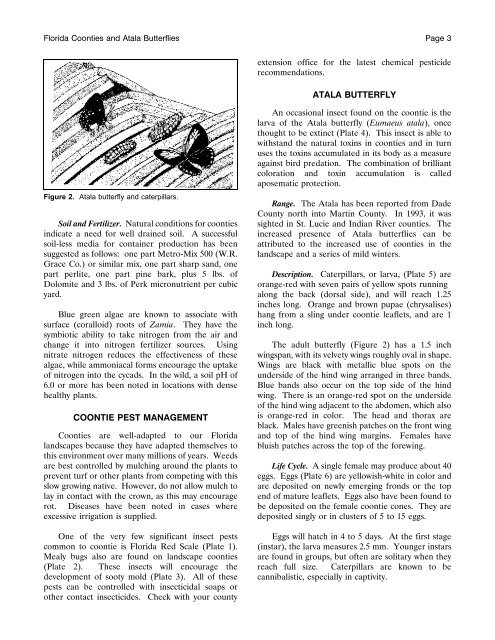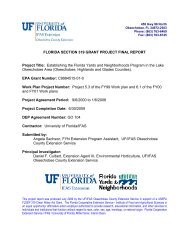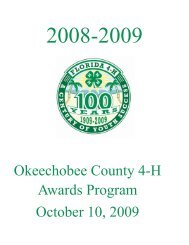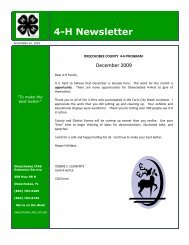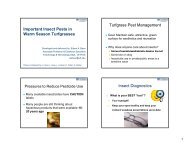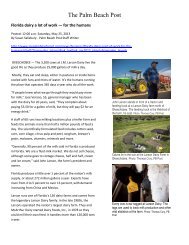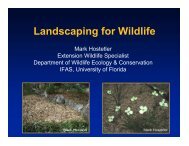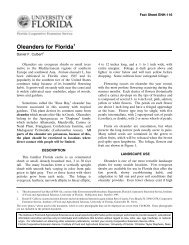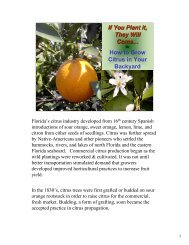Florida Coonties and Atala Butterflies - Palm and Cycad Societies of ...
Florida Coonties and Atala Butterflies - Palm and Cycad Societies of ...
Florida Coonties and Atala Butterflies - Palm and Cycad Societies of ...
You also want an ePaper? Increase the reach of your titles
YUMPU automatically turns print PDFs into web optimized ePapers that Google loves.
<strong>Florida</strong> <strong>Coonties</strong> <strong>and</strong> <strong>Atala</strong> <strong>Butterflies</strong> Page 3extension <strong>of</strong>fice for the latest chemical pesticiderecommendations.ATALA BUTTERFLYFigure 2. <strong>Atala</strong> butterfly <strong>and</strong> caterpillars.Soil <strong>and</strong> Fertilizer. Natural conditions for coontiesindicate a need for well drained soil. A successfulsoil-less media for container production has beensuggested as follows: one part Metro-Mix 500 (W.R.Grace Co.) or similar mix, one part sharp s<strong>and</strong>, onepart perlite, one part pine bark, plus 5 lbs. <strong>of</strong>Dolomite <strong>and</strong> 3 lbs. <strong>of</strong> Perk micronutrient per cubicyard.Blue green algae are known to associate withsurface (coralloid) roots <strong>of</strong> Zamia. They have thesymbiotic ability to take nitrogen from the air <strong>and</strong>change it into nitrogen fertilizer sources. Usingnitrate nitrogen reduces the effectiveness <strong>of</strong> thesealgae, while ammoniacal forms encourage the uptake<strong>of</strong> nitrogen into the cycads. In the wild, a soil pH <strong>of</strong>6.0 or more has been noted in locations with densehealthy plants.COONTIE PEST MANAGEMENT<strong>Coonties</strong> are well-adapted to our <strong>Florida</strong>l<strong>and</strong>scapes because they have adapted themselves tothis environment over many millions <strong>of</strong> years. Weedsare best controlled by mulching around the plants toprevent turf or other plants from competing with thisslow growing native. However, do not allow mulch tolay in contact with the crown, as this may encouragerot. Diseases have been noted in cases whereexcessive irrigation is supplied.One <strong>of</strong> the very few significant insect pestscommon to coontie is <strong>Florida</strong> Red Scale (Plate 1).Mealy bugs also are found on l<strong>and</strong>scape coonties(Plate 2). These insects will encourage thedevelopment <strong>of</strong> sooty mold (Plate 3). All <strong>of</strong> thesepests can be controlled with insecticidal soaps orother contact insecticides. Check with your countyAn occasional insect found on the coontie is thelarva <strong>of</strong> the <strong>Atala</strong> butterfly (Eumaeus atala), oncethought to be extinct (Plate 4). This insect is able towithst<strong>and</strong> the natural toxins in coonties <strong>and</strong> in turnuses the toxins accumulated in its body as a measureagainst bird predation. The combination <strong>of</strong> brilliantcoloration <strong>and</strong> toxin accumulation is calledaposematic protection.Range. The <strong>Atala</strong> has been reported from DadeCounty north into Martin County. In 1993, it wassighted in St. Lucie <strong>and</strong> Indian River counties. Theincreased presence <strong>of</strong> <strong>Atala</strong> butterflies can beattributed to the increased use <strong>of</strong> coonties in thel<strong>and</strong>scape <strong>and</strong> a series <strong>of</strong> mild winters.Description. Caterpillars, or larva, (Plate 5) areorange-red with seven pairs <strong>of</strong> yellow spots runningalong the back (dorsal side), <strong>and</strong> will reach 1.25inches long. Orange <strong>and</strong> brown pupae (chrysalises)hang from a sling under coontie leaflets, <strong>and</strong> are 1inch long.The adult butterfly (Figure 2) has a 1.5 inchwingspan, with its velvety wings roughly oval in shape.Wings are black with metallic blue spots on theunderside <strong>of</strong> the hind wing arranged in three b<strong>and</strong>s.Blue b<strong>and</strong>s also occur on the top side <strong>of</strong> the hindwing. There is an orange-red spot on the underside<strong>of</strong> the hind wing adjacent to the abdomen, which alsois orange-red in color. The head <strong>and</strong> thorax areblack. Males have greenish patches on the front wing<strong>and</strong> top <strong>of</strong> the hind wing margins. Females havebluish patches across the top <strong>of</strong> the forewing.Life Cycle. A single female may produce about 40eggs. Eggs (Plate 6) are yellowish-white in color <strong>and</strong>are deposited on newly emerging fronds or the topend <strong>of</strong> mature leaflets. Eggs also have been found tobe deposited on the female coontie cones. They aredeposited singly or in clusters <strong>of</strong> 5 to 15 eggs.Eggs will hatch in 4 to 5 days. At the first stage(instar), the larva measures 2.5 mm. Younger instarsare found in groups, but <strong>of</strong>ten are solitary when theyreach full size. Caterpillars are known to becannibalistic, especially in captivity.


